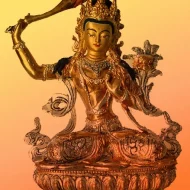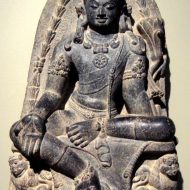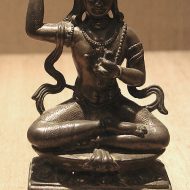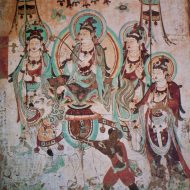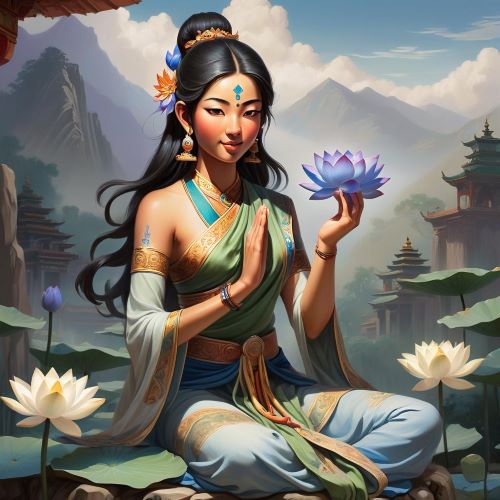Manjushri : God of Wisdom
Listen
At a glance
| Description | |
|---|---|
| Origin | Tibetan Mythology |
| Classification | Gods |
| Family Members | N/A |
| Region | Tibet |
| Associated With | Wisdom, Enlightenment |
Manjushri
Introduction
Manjushri, also recognized as Jampelyang in Tibetan, holds a pivotal role within Mahayana Buddhism, specifically in the tapestry of Tibetan mythology. As a bodhisattva intricately linked with prajñā, or wisdom, his very name, “Gentle Glory,” conveys his essence in Sanskrit. Amid the pantheon of venerated figures, Manjushri assumes a preeminent position as a Bodhisattva, embodying the quintessence of wisdom and knowledge. His presence transcends the confines of religious distinctions, reaching far beyond the geographical boundaries of Tibet.
Physical Traits
Physical representations of Manjushri may exhibit some variations, but he is frequently depicted as a youthful and timeless figure, embodying the concept of perpetual youth and divine wisdom. One of the most common depictions portrays him holding a flaming sword in his right hand, symbolizing the potent ability of wisdom to cleave through the veils of ignorance. In his left hand, he cradles a lotus flower, atop which lies the Prajnaparamita Sutra, a sacred scripture representing the wisdom of comprehending emptiness.
Within the realm of Tibetan iconography, Manjushri typically takes on the form of a radiant and youthful being, radiating an aura of transcendent wisdom and serenity. Often, he is adorned with a regal crown, signifying his exalted status as a bodhisattva. His serene and luminescent countenance mirrors his unwavering dedication to the pursuit of wisdom and enlightenment.
A central and distinctive aspect of Manjushri’s portrayal is his iconic attribute: the sword of wisdom, referred to as “Khadga” in Sanskrit. This powerful sword, grasped in his right hand, symbolizes the capacity of wisdom to slice through the fog of ignorance and delusion. It stands as a compelling emblem of the transformative and illuminating essence of wisdom.
In his left hand, Manjushri often cradles a lotus flower, atop which rests a copy of the Prajnaparamita Sutra, a venerated text in Mahayana Buddhism. The lotus is emblematic of the purity of knowledge, while the scripture serves as an embodiment of Manjushri’s role as the deity of profound wisdom and discernment.
Family
In the vast pantheon of Buddhist deities, Manjushri is considered a bodhisattva, a being who seeks enlightenment not only for themselves but for the benefit of all sentient beings. While not typically associated with a specific family, he is often depicted alongside other bodhisattvas and enlightened beings.
Other names
Manjushri is hailed by various names across diverse cultures and languages. In Sanskrit, he goes by the moniker Mañjuśrīkumārabhūta, signifying “Manjushri, Still a Youth” or “Prince Manjushri”. Another Sanskrit title associated with Manjushri is Mañjughoṣa. In the Chinese tradition, he is recognized as Wénshū Púsà, while the Japanese refer to him as Monju Bosatsu. Within the realm of Tibetan Buddhism, Manjushri bears several names and honorific titles. One of his alternative designations is “Manjughosa,” meaning “Sweet-Sounding Voice” or “Gentle Sound.” This particular epithet emphasizes the harmonious and comforting essence of his teachings and guidance.
Powers and Abilities
Manjushri’s paramount power is intricately tied to his embodiment of transcendent wisdom, known as prajñā. It is believed that he possesses the capacity to dispel ignorance and illuminate the path to enlightenment. His flaming sword serves as a symbolic representation of this ability to slice through delusion and misunderstanding. In certain traditions, Manjushri is also affiliated with the practice of debate, symbolizing the use of discerning wisdom to vanquish harmful misconceptions.
Manjushri’s connection to the Prajnaparamita Sutra, embodied by the scripture he cradles, underscores his role as the deity of profound wisdom and insight. The lotus flower, emerging gracefully from the pages of the sacred book, symbolizes the untarnished purity of knowledge, free from impurities and illusions.
In his capacity as the embodiment of wisdom, Manjushri diligently steers individuals on their spiritual journeys, aiding them in achieving a deeper comprehension of reality and the path to enlightenment. He possesses the extraordinary ability to unravel the intricate complexities of existence, thus illuminating the way for those earnestly seeking the truth.
Modern Day Influence
Manjushri’s revered status endures in contemporary Mahayana and Vajrayana Buddhism. His likeness frequently graces Buddhist art and iconography, while his mantras are chanted to invoke wisdom and clarity of understanding. Manjushri’s sphere of influence transcends the bounds of religious rituals, with his name and visage making appearances in literature, art, and cultural allusions.
In the realm of modern Tibetan Buddhism, Manjushri remains an object of veneration as the embodiment of wisdom. Devotees continue to seek his guidance to enrich their comprehension and insight. His wisdom sword retains its potent symbolism, representing the capacity to cut through ignorance and delusion, thus offering inspiration to those on the path to enlightenment.
Manjushri’s impact extends beyond spiritual practices to permeate art and literature. Artists, particularly in Tibet and regions influenced by Tibetan culture, frequently feature him in their works, emphasizing not only his serene countenance but also the wisdom he personifies. Writers and poets draw upon his character to delve into themes of knowledge and enlightenment.
Moreover, beyond the confines of Buddhism, Manjushri’s wisdom sword has made a distinct impression on the philosophy of martial arts. It serves as a powerful emblem of precision, focus, and the ability to distinguish truth from falsehood. This influence underscores the universal resonance of Manjushri’s teachings and the enduring relevance of his message of wisdom and enlightenment.
Related Images
Frequently Asked Questions
What is lorem Ipsum?
I am text block. Click edit button to change this text. Lorem ipsum dolor sit amet, consectetur adipiscing elit. Ut elit tellus, luctus nec ullamcorper mattis, pulvinar dapibus leo.
What is lorem Ipsum?
I am text block. Click edit button to change this text. Lorem ipsum dolor sit amet, consectetur adipiscing elit. Ut elit tellus, luctus nec ullamcorper mattis, pulvinar dapibus leo.
What is lorem Ipsum?
I am text block. Click edit button to change this text. Lorem ipsum dolor sit amet, consectetur adipiscing elit. Ut elit tellus, luctus nec ullamcorper mattis, pulvinar dapibus leo.
What is lorem Ipsum?
I am text block. Click edit button to change this text. Lorem ipsum dolor sit amet, consectetur adipiscing elit. Ut elit tellus, luctus nec ullamcorper mattis, pulvinar dapibus leo.
What is lorem Ipsum?
I am text block. Click edit button to change this text. Lorem ipsum dolor sit amet, consectetur adipiscing elit. Ut elit tellus, luctus nec ullamcorper mattis, pulvinar dapibus leo.



